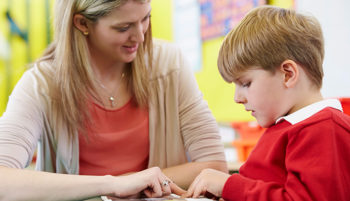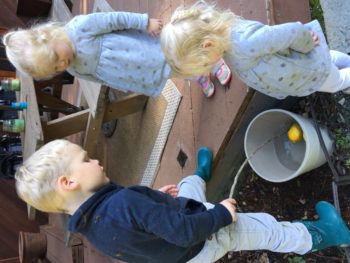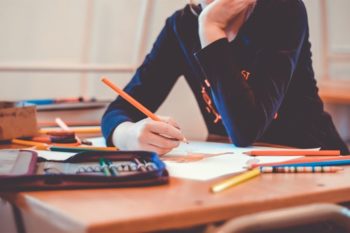Focusing on Your Child’s Learning Progress and Not Perfection
“Take pride in how far you’ve come. Have faith in how far you can go. But don’t forget the journey.” by Michael Josephson
 We knew the school year would end when the year started, but never realized how fast it would come. It’s hard to stop, step back, and just look at how far we’ve come. The mountains we have climbed or the forever-long valleys that we thought would never end, but we did it. We all did hard things. We grew.
We knew the school year would end when the year started, but never realized how fast it would come. It’s hard to stop, step back, and just look at how far we’ve come. The mountains we have climbed or the forever-long valleys that we thought would never end, but we did it. We all did hard things. We grew.
As a special education teacher, I’ve had the privilege of watching hundreds of students grow academically, socially, emotionally, and personally. Some students leap ahead quickly, others take smaller steps, and a few struggle quietly in the shadows. But one thing I’ve learned is this: progress looks different for every child, and it all matters. Every small victory, no matter how tiny it may seem, deserves to be celebrated at the end of the year or whenever they happen.
As parents, getting caught up in benchmarks, grades, comparisons, or even the long road ahead is easy. We worry if our child is reading at grade level, keeping up in math, or getting along with others. We scroll through social media and see other kids’ achievements and start wondering, “Are we doing enough? Is my child falling even further behind with everything we’re doing?” But I want to remind you: Your child’s journey is their own. And every bit of progress counts.
Why Focusing on Progress Matters
Children are not machines—they don’t develop at the same pace or in the same way. Some kids take off in reading in kindergarten, while others might not find their rhythm until second or third grade. Some struggle with reading or math for years, then suddenly it comes together. The path isn’t linear. It’s full of dips, turns, plateaus, and bursts.
When we celebrate only the big moments—the awards, the perfect test scores, the standout performances—we unintentionally send a message that only perfection is worthy of praise. But when we recognize the small wins—completing a book, staying focused for 10 minutes, asking for help, using kind words—we help our children build confidence and resilience.
Progress is what leads to success. And acknowledging it fuels motivation.
What Small Victories Look Like
Small victories aren’t always flashy. They often happen quietly, in moments you might miss if you aren’t watching closely. Here are just a few examples I’ve seen:
- A student who used to avoid reading time finally picks a book on their own
- A child who struggles with handwriting writes a whole sentence without giving up
- A student with anxiety raises their hand to answer a question in front of the class
- A child who’s been impulsive takes a deep breath and uses a strategy to stay calm
- A third grader remembers their math facts with just a little less prompting
These are real, meaningful steps forward. They’re often the result of hard work, perseverance, and support—both at school and at home. And they’re worth celebrating. And perhaps a very loud cheerleader in your corner, never giving up and always moving the needle forward no matter the time of year.
Shifting the Focus at Home
So, how can you, as a parent, help your child focus on progress rather than perfection? Here are a few ideas that come straight from my experience in the classroom and conversations with other families:
- Notice the Effort: Instead of asking, “Did you get 100%?” try asking, “What did you learn today?” or “What felt easier than it used to?” Celebrate the effort your child puts into their work, even if the result isn’t perfect. Praise things like persistence, creativity, courage, and problem-solving.
- “Last Day” Shout-Out: Take a picture of your child holding a sign that celebrates a specific win (“I mastered my multiplication facts!” or “I learned to ask for help when I need it!”).
- Special Treat or Activity: Let them pick a fun, low-cost way to celebrate: a walk to the park, popsicles after dinner, or staying up 15 minutes later.
- Create a Victory Journal or Jar: Start a family habit of writing down “wins” in a notebook or dropping notes in a jar. They can be school-related or personal: “I stood up for a friend today.” “I tried broccoli again.” “I spelled ‘because’ right without looking.” Review these wins regularly. They become a tangible reminder of growth.
- Reframe Comparison: When your child says, “Everyone else is better than me,” gently remind them that every learner is on their own path. You can say, “Let’s talk about how far you’ve come,” and point to specific examples. Try using “then and now” language: “You used to need help to read that page. Now you can do it on your own!”
A Word of Encouragement
If your child is struggling, whether it’s with schoolwork, behavior, or friendships, please know this: their struggles do not define them. They are growing every day in ways that may not show up on a report card. And you, as their parent, are making a difference, just by cheering them on.
You don’t need to wait for perfect moments to celebrate your child. Celebrate when they keep trying. Celebrate when they show kindness. Celebrate when they bounce back from disappointment and when they take those first steps down the stairs on their own. These are the victories that shape character and build lifelong learners.
End of the School Year Growth Reflections
As we wrap up the school year, it’s the perfect time to reflect not only on report card grades but also on the many layers of growth that might not show up in traditional ways. Whether your child is in kindergarten or high school, every grade level presents unique challenges, and every child makes progress in their own time. Maybe your first grader finally mastered those tricky sight words, or your middle schooler became more independent with homework. Maybe your high schooler stepped up with better time management, stronger self-advocacy or learned how to cook. These are the wins that build confidence and maturity, and they deserve recognition just as much as academic scores.
For families of students with IEPs, this time of year can bring both pride and questions. You may be reviewing progress reports and wondering how your child did on their goals. While some IEP goals may be fully met, others might still be in progress, and that’s okay. IEPs are living documents meant to grow with your child. Progress on goals, even if it’s not complete, often reflects significant growth: increased independence, improved focus, or stronger communication skills. When you look at the progress, try to see the full picture of effort, support, and resilience. Celebrate what your child has accomplished—and know that every step forward, no matter how small, is a step toward greater success next year.
Tell Students How Much They Have Accomplished
In my classroom, I make it a point to recognize progress out loud. I say things like, “I know that was hard for you. I love how you persevered through it.” I invite you to do the same at home.
Ultimately, education is a marathon, not a sprint. By shifting our focus from the idea of perfection to the tangible reality of progress, we empower our children and uplift ourselves. Let’s choose to see the beauty in each small victory, for it is in these moments that we truly see the strength, resilience, and spirit of our children.
Education is about celebrating the little things as we climb the mountain to graduation. Celebrate every tiny victory. Those things matter.
As the year comes to a close, from learning to walk up or down the stairs to taking the first steps to learning to read or making it to all your classes to graduate–those little things matter. What can you help your child celebrate?
 Summer Learning for Kids!
Summer Learning for Kids! We knew the school year would end when the year started, but never realized how fast it would come. It’s hard to stop, step back, and just look at how far we’ve come. The mountains we have climbed or the forever-long valleys that we thought would never end, but we did it. We all did hard things. We grew.
We knew the school year would end when the year started, but never realized how fast it would come. It’s hard to stop, step back, and just look at how far we’ve come. The mountains we have climbed or the forever-long valleys that we thought would never end, but we did it. We all did hard things. We grew. It’s funny once you hit Spring Break blink and it is summer break. Where did the year go? How was the year? Before rushing into vacation mode, here are a couple of things you can do to make sure the year ends on a good note and set up our children for success next year.
It’s funny once you hit Spring Break blink and it is summer break. Where did the year go? How was the year? Before rushing into vacation mode, here are a couple of things you can do to make sure the year ends on a good note and set up our children for success next year. Helping Kids with ADHD Focus: Classroom and Home Strategies
Helping Kids with ADHD Focus: Classroom and Home Strategies Why Does My Child Need Assessments?
Why Does My Child Need Assessments?